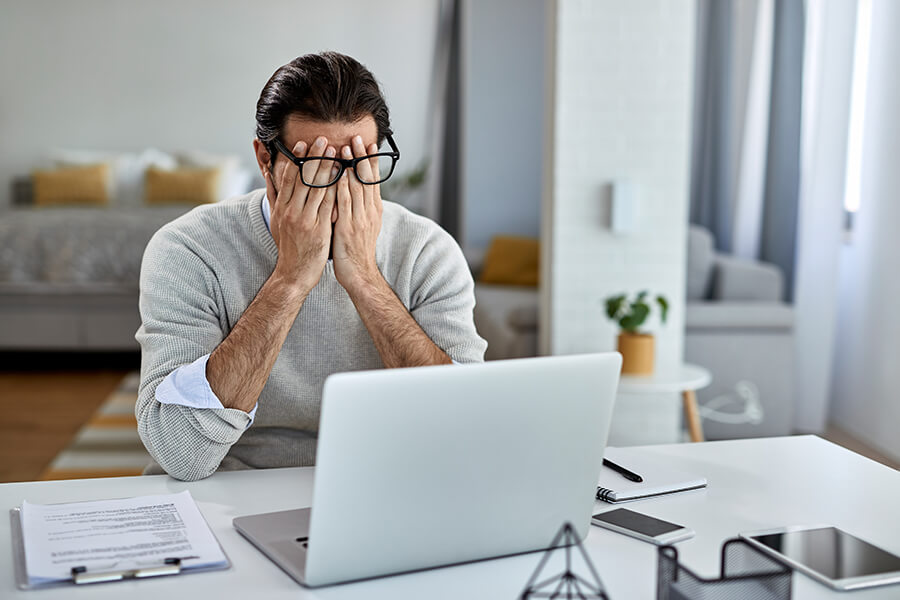
05 Jul What is Eyestrain: Symptoms and Causes?
Introduction
In today’s digital age, many of us spend a significant amount of time in front of screens, leading to increased instances of eyestrain. Eyestrain, also known as asthenopia, is a common condition characterized by discomfort or fatigue in the eyes. It can occur due to various factors, including prolonged screen time, improper lighting, and poor visual habits. In this article, we will explore the symptoms and causes of eyestrain, helping you understand this condition and take steps to prevent and alleviate it for healthier and more comfortable vision.
Symptoms of Eyestrain
Eyestrain can manifest through several symptoms, which may vary in intensity from person to person. Some common signs of eyestrain include:
- Eye fatigue and tiredness
- Dry, gritty, or watery eyes
- Blurred or double vision
- Headaches or migraines
- Increased sensitivity to light
- Difficulty concentrating
- Neck, shoulder, or back pain (associated with poor posture)
It’s important to note that the symptoms of eyestrain may overlap with other vision-related conditions, so it’s advisable to consult an eye care professional for an accurate diagnosis.
Causes of Eyestrain
Eyestrain can result from a combination of factors, including:
- Prolonged screen time: Extensive use of digital devices, such as computers, smartphones, and tablets, can lead to eyestrain. The constant focus on a screen and the exposure to blue light emitted by these devices contribute to eye fatigue and discomfort.
- Improper lighting conditions: Insufficient or excessive lighting can strain the eyes. Poorly lit environments, glare from windows or overhead lights, or working in dimly lit spaces can all contribute to eyestrain.
- Incorrect prescription or uncorrected vision problems: Wearing outdated or incorrect eyeglasses can strain the eyes, as the eyes work harder to compensate for vision deficiencies. It’s crucial to have regular eye exams to ensure your prescription is up to date.
- Poor ergonomics and posture: Sitting in an uncomfortable position or adopting improper posture while working or reading can contribute to eyestrain. When the body is not aligned correctly, it can cause strain on the eyes, neck, and back.
- Lack of breaks and eye exercises: Focusing on a specific task for prolonged periods without taking breaks strains the eyes. Additionally, not practicing eye exercises or giving the eyes regular rest can contribute to eyestrain.
Prevention and Relief
There are several steps you can take to prevent and alleviate eyestrain:
- Follow the 20-20-20 rule: Every 20 minutes, pause and focus on an object 20 feet away for at least 20 seconds.
- Adjust screen settings: Ensure that your computer or device screen is properly adjusted to minimize glare and optimize contrast and brightness levels.
- Optimize lighting: Position your workstation in a way that reduces glare and provides adequate lighting. Avoid using screens in overly bright or dimly lit environments.
- Practice proper ergonomics: Maintain good posture while working or reading. Position your screen at eye level and ensure a comfortable distance between your eyes and the screen.
- Use artificial tears: If you experience dryness or irritation, consider using artificial tear drops to lubricate your eyes and provide relief.
- Regular eye exams: Schedule routine eye exams to detect any vision changes or update your prescription if needed.
- Consider specialized eyewear: Depending on your specific needs, your eye care professional may recommend specialized lenses, such as blue light-filtering lenses or computer glasses, to reduce eyestrain during screen time.
Conclusion
Eyestrain is a common condition that can affect anyone, especially those who spend extended periods in front of screens or engage in visually demanding tasks. By understanding the symptoms and causes of eyestrain, you can take proactive steps to prevent and alleviate discomfort. Prioritizing proper eye care, following healthy visual habits, and making necessary adjustments to your environment can go a long way in promoting healthier and more comfortable vision. Remember, if you experience persistent or severe symptoms, it’s important to consult an eye care professional for a thorough evaluation and personalized recommendations.


No Comments